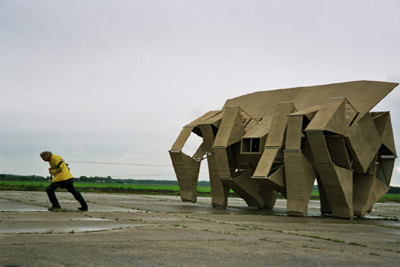How fitting that in Holland, land of windmills, an artist has created large wind-powered robots! Dutch kinetic sculptor, Theo Jansen combines a vivid artistic imagination with a background in science to create fantastic mobile creations. Made of plastic ribs, flexible pneumatic tubes, sails and sensors, Jansen uses computer simulations to perfect his designs before taking them for trial runs on the beaches of Holland. As the artworks lumber into motion, one sees slow-gaited giants, looking like extraterrestrial visitors, moving in herd-like unison. The artist refers to them simply as Strandbeesten, beach-animals. His ultimate aim, stated at a TED conference in 2007, is to make the organisms independent so that they can survive on the beach for long periods without the artist’s assistance. “A good advantage of the animals is they don’t have to eat–they eat the wind,” Jansen says. “That’s why they might have a chance on the beaches: There’s a lot of wind, not much food.” This is robotics without motors or computer chips, living not in outer space, not in factories or labs, but in an unsupervised ocean wilderness. The world of Philip K. Dick has arrived! In 1968 (Do Androids Dream of Electric Sheep), Dick predicted that with the mass extinction of mammals from our planet, people would turn to robotic pets and virtual animals for comfort. Thanks Kate for bringing this artist to my attention.
To contrast this wind-powered artwork with another, here’s a work by New York artist Joshua Allen Harris, Polar Bears.
I find it telling that the above two videos feature artists in the context of ads; one promotes BMW cars and the other promotes public transport. Both artworks seem to be inspired by the rapid extinction of animals from our planet; both artworks explore the relationship between an artwork and the environment it is placed in, using wind power to bring inanimate structures to life. Both use common materials. Jansen’s work suggests the limitless possibilities of ingenious engineering. Harris’s work combines humour with pathos, using the onrushing wind from an unseen subway train to suggest a momentary breath of life. His mother bear and cub make a modest and fleeting appearance, and their loss of air and slow collapse reminds the viewer of the fragility of all life forms.
